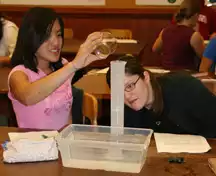Integrating Measurement and Uncertainty into Science Instruction
This material is replicated on a number of sites
as part of the
SERC Pedagogic Service Project
Initial Publication Date: November 4, 2009

William Thompson, aka Lord Kelvin
What is Measurement and Uncertainty?
Measurement is fundamental to science. While measurement might sometimes seem obvious, students can harbor basic misconceptions about measurement that prevent them from understanding science concepts. In particular, students often don't always understand what conclusions can or cannot be reached based on the degree of uncertainty of measurements they make (Allie et al, 2003). These misunderstandings can affect their ability to acquire knowledge during hands-on, inquiry-based learning (Kanari and Millar, 2004). The goal of this module is to provide science educators clearly written, effective material to teach introductory level students the fundamentals of effective measurement, and describe how to integrate these ideas into science teaching. This module provides instructional material appropriate for high school and introductory college students that is conceptually consistent with the methods of measurement taught at more advanced levels and used in industry. In addition, this module shows how to adapt lab activities so that they are consistent with this approach.find more information about measurement and uncertainty
Why Teach Measurement and Uncertainty?

Professor Walter Lewin, MIT
- Understanding measurement uncertainty helps students use data they collect during inquiry-based learning to reach accurate conclusions. Students who do not understand measurement uncertainty have difficulty seeing underlying science relationships if they are buried under measurement uncertainty. (Kanari and Millar 2004)
- Measurement uncertainty is an important element of scientific literacy. (AAAS benchmarks, IPCC report)
- Measurement as it is traditionally taught in most high school and introductory college courses may not give students the foundation on which to build future understanding of science and measurement (Allie et al, 2003). The traditional approach used in most high school and introductory college courses has students learn how to use significant figures to imply uncertainty in a measurement. More advanced college courses and research labs use methods consistent with the scientifically standardized approaches to measurement uncertainty (ISO GUM and NIST Guide).
How to Integrate Measurement and Uncertainty into Science Instruction
This module includes three types of materials for teachers to use to teach effective measurement:- Packets of instructional material to teach effective measurement technique. These packets teach students the concepts of measurement uncertainty and how to determine the uncertainty of measurements they make and numbers calculated using measured values.
- Activities specifically intended to teach effective measurement.
- Examples of how to convert labs so they are consistent with the methods described here.









